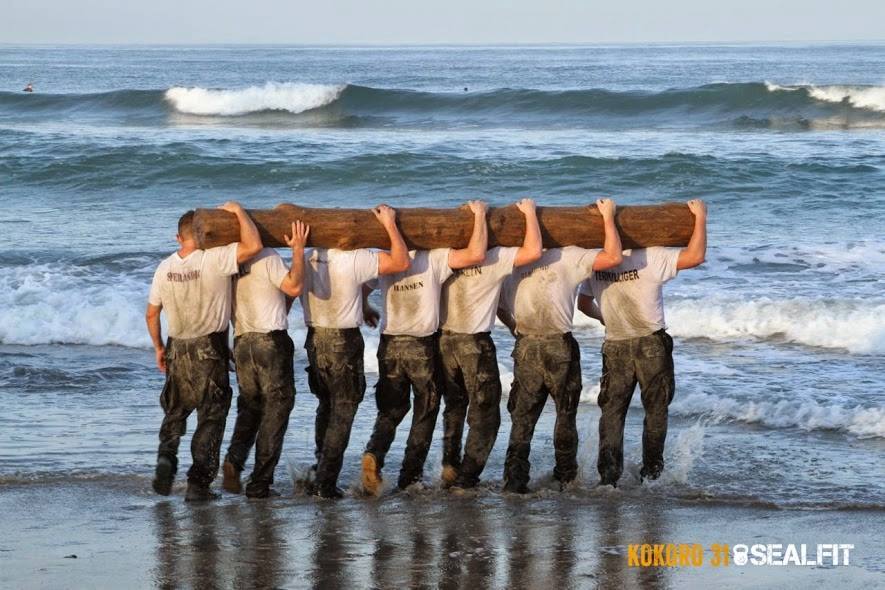SURVIVING SEALFIT: What Happened When a Regular Guy Tried to Train Like a Navy SEAL
![]()
I’m probably in big trouble. That’s the first thought that hit me as I lay on the floor panting in a puddle of sweat.
Just behind me, an elderly woman casually glided on an elliptical machine. To my right, a couple of guys were giving me puzzled looks on their break between sets of Bench Press. I appeared to be the only person who had decided to suffer so egregiously at such an early hour of the morning.
It had been a week since a story by a friend had inspired me to try a Navy SEAL-style training regimen. The early results were not encouraging.

SEALFIT uses creative ways to challenge your body and mind, all while using minimal equipment. (Image courtesy of SEALFIT)
The workouts were easily the most difficult I’d ever undertaken in 18 years of training regularly. This scene—the one in which I’m wiped out on the floor, gasping for air—happened during pretty much every workout at one point or another. Sometimes it occurred more than once in a session. And when it did, it wasn’t just humbling. It was also awkward, since I train at a gym where normal people, many of them over age 50, do normal workouts. At the end of their training sessions, most did not look like a train wreck. I did.
Anyway, the story that started all of this was written by a freelance writer and STACK Contributor named T.J. Murphy, who recounted his experience with a group called SEALFIT. Founded by retired Navy SEAL Commander Mark Divine, SEALFIT combines elements of the training done by candidates for the Special Forces with the type of high-intensity weight training you find at a CrossFit box—mixing in yoga, meditation, and team-building exercises. The result is a program designed to make you physically stronger, mentally tougher, and more emotionally resilient.
The group—which consists mostly of current or former Navy SEALs, like Divine—trains athletes, including actual soldiers, out of its headquarters in Encinitas, California. But SEALFIT also puts on camps or “challenges” modeled after the SEALs Hell Week. Some of these events last 12 or so hours, while others—called Kokoro—span three days and come complete with regimens of punishing calisthenics, long marches with weighted packs, “surf torture,” where you get belted in the face by onrushing waves, and intense weightlifting sessions, one of which Murphy described as follows:
At around two o’clock, we were broken into teams of four and given a 250-pound wooden log to lift, as a group, over our heads. Then we circled a 600-pound tractor tire and lifted it to our chins. The coaches thought our lifts looked sloppy, so they made us do it more than a dozen times. To put more force into my lifts, I was contorting my back like a rabid dog, but I could feel myself fizzling. There was no sign of a break coming soon.
I can’t tell you exactly which part of Murphy’s story appealed to me. Maybe I’m just a sucker for the words “surf torture.” For whatever reason—well, several reasons, as I’d later find out—I felt I had to try one of these events. I wanted to see if I could survive SEALFIT.

Participants at a SEALFIT Kokoro head out for fun in the surf carrying a 250-pound log. (Image courtesy of SEALFIT)
I made one decision right away: I would not jump directly into a Kokoro. My reasoning was simple: Murphy didn’t finish his Kokoro. Though at 34 years old, I am 16 years younger than Murphy, he’s a five-time Ironman finisher and a committed CrossFitter. I’m a guy with a desk job who ran a half-marathon last year. I like to think I’m in decent shape, but I haven’t followed any kind of consistent training plan since the birth of my daughter two years ago. I’m not at what anyone would consider an “elite” level of fitness.
So rather than jump directly into the deep end of the paramilitary training pool, I would first see if I could make it through SEALFIT’s one-day event, called a 20X Challenge. Though shorter in duration than a Kokoro, the 20X Challenge is still an intense experience. Want proof? Watch this video, and keep in mind that the guys (and one girl) you see struggling through it are linemen, people who climb telephone poles to fix electrical outages during thunderstorms. Their jobs require them to be in shape and fearless. They are not people who sit at desks and type, as I’ve been doing for the past two hours.
Anyway, one of these 20X Challenges takes place in June in Allentown, Pennsylvania—not terribly far from STACK’s offices in Cleveland. It seemed like the perfect option: within driving distance and far enough into the future that I’d have enough time to whip myself into shape.
At least that’s what I thought. A week into training for the event, I’d began to wonder how I’d survive several months of this.
During that first week, I followed the workout plan of another STACK Contributor, Brad McLeod. At his website SEALGrinderPT.com, McLeod provides daily workouts (called WODs), which prove that your body weight can be your worst enemy (which is fitting, since the article that originally led me to McLeod covered his “20-Minute No Excuses Bodyweight Workout”). Most of McLeod’s routines involve little or no equipment, but still leave you thoroughly crushed at the end.
I was in the midst of his “Blitz” WOD when I wound up flattened on the floor behind elliptical lady. The routine looked simple on paper: Cover 500 meters on a rowing machine, do 20 Push-Ups, 25 Sit-Ups and 6 Pull-Up, then finish with a quarter-mile run.
Now do that entire sequence four more times, for five rounds total, as fast as you can.
By the fourth round, I was definitely in that place you might call “the red”—you know, the place on your car’s instrument panel that indicates something is about to blow. That was how I felt, like an overheating engine sputtering its way toward an inevitable halt. The crash hit after the row in round five.

This is how the author felt during the “Blitz” workout. (Image: Thinkstock)
Yup, I’m in trouble. I thought to myself on the floor, unable to catch my breath. Dunno if I can finish this one out.
One of the phrases the SEALFIT crew uses a lot is “staying in the fight.” Essentially, it means you must continue to work to the finish, even when it seems hopeless, even if it means you have to do your 20 Push-Ups in two sets of five, one set of three, a set of two, another set of two, and three flailing sets of one, as I had to do that day. As long as you don’t quit, you’ll eventually reach your goal.
When I finished the last quarter mile of that fifth round, I was completely exhausted. But I also felt a strong sense of pride and accomplishment. I had “stayed in the fight” and finished the workout, like I had several other times that week.
It was a good feeling for the moment. But in a few days, I would learn that I hadn’t gotten to the tough stuff yet.
Related Posts:
SURVIVING SEALFIT, part 1: What Happened When a Regular Guy Tried to Train Like a Navy SEAL
SURVIVING SEALFIT, part 2: 3 Ways SEAL-Style Workouts Change Your Life
SURVIVING SEALFIT, part 3: The World’s Hardest Workout Has a Ridiculous Name
SURVIVING SEALFIT, part 5: How Not to Hurt Yourself (Like I Did)
SURVIVING SEALFIT, part 6: Finding the Silver Lining
SURVIVING SEALFIT, part 7: The Question That Tells You Whether You’ll Succeed
SURVIVING SEALFIT, part 8: Meet 3 Guys Who Might Kill Me
SURVIVING SEALFIT, part 9: The Dress Rehearsal
SURVIVING SEALFIT, part 10: What a SEALFIT 20X Challenge is REALLY Like
*****
Surviving SEALFIT is STACK Executive Editor Brian Sabin‘s account of his quest to reach elite military grade fitness, take on a SEALFIT 20X Challenge and (hopefully) live to tell about it. He’ll publish weekly accounts of his ups and downs here at STACK.com. You can also find him posting daily updates on Twitter and Google Plus.
RECOMMENDED FOR YOU
MOST POPULAR
SURVIVING SEALFIT: What Happened When a Regular Guy Tried to Train Like a Navy SEAL
![]()
I’m probably in big trouble. That’s the first thought that hit me as I lay on the floor panting in a puddle of sweat.
Just behind me, an elderly woman casually glided on an elliptical machine. To my right, a couple of guys were giving me puzzled looks on their break between sets of Bench Press. I appeared to be the only person who had decided to suffer so egregiously at such an early hour of the morning.
It had been a week since a story by a friend had inspired me to try a Navy SEAL-style training regimen. The early results were not encouraging.

SEALFIT uses creative ways to challenge your body and mind, all while using minimal equipment. (Image courtesy of SEALFIT)
The workouts were easily the most difficult I’d ever undertaken in 18 years of training regularly. This scene—the one in which I’m wiped out on the floor, gasping for air—happened during pretty much every workout at one point or another. Sometimes it occurred more than once in a session. And when it did, it wasn’t just humbling. It was also awkward, since I train at a gym where normal people, many of them over age 50, do normal workouts. At the end of their training sessions, most did not look like a train wreck. I did.
Anyway, the story that started all of this was written by a freelance writer and STACK Contributor named T.J. Murphy, who recounted his experience with a group called SEALFIT. Founded by retired Navy SEAL Commander Mark Divine, SEALFIT combines elements of the training done by candidates for the Special Forces with the type of high-intensity weight training you find at a CrossFit box—mixing in yoga, meditation, and team-building exercises. The result is a program designed to make you physically stronger, mentally tougher, and more emotionally resilient.
The group—which consists mostly of current or former Navy SEALs, like Divine—trains athletes, including actual soldiers, out of its headquarters in Encinitas, California. But SEALFIT also puts on camps or “challenges” modeled after the SEALs Hell Week. Some of these events last 12 or so hours, while others—called Kokoro—span three days and come complete with regimens of punishing calisthenics, long marches with weighted packs, “surf torture,” where you get belted in the face by onrushing waves, and intense weightlifting sessions, one of which Murphy described as follows:
At around two o’clock, we were broken into teams of four and given a 250-pound wooden log to lift, as a group, over our heads. Then we circled a 600-pound tractor tire and lifted it to our chins. The coaches thought our lifts looked sloppy, so they made us do it more than a dozen times. To put more force into my lifts, I was contorting my back like a rabid dog, but I could feel myself fizzling. There was no sign of a break coming soon.
I can’t tell you exactly which part of Murphy’s story appealed to me. Maybe I’m just a sucker for the words “surf torture.” For whatever reason—well, several reasons, as I’d later find out—I felt I had to try one of these events. I wanted to see if I could survive SEALFIT.

Participants at a SEALFIT Kokoro head out for fun in the surf carrying a 250-pound log. (Image courtesy of SEALFIT)
I made one decision right away: I would not jump directly into a Kokoro. My reasoning was simple: Murphy didn’t finish his Kokoro. Though at 34 years old, I am 16 years younger than Murphy, he’s a five-time Ironman finisher and a committed CrossFitter. I’m a guy with a desk job who ran a half-marathon last year. I like to think I’m in decent shape, but I haven’t followed any kind of consistent training plan since the birth of my daughter two years ago. I’m not at what anyone would consider an “elite” level of fitness.
So rather than jump directly into the deep end of the paramilitary training pool, I would first see if I could make it through SEALFIT’s one-day event, called a 20X Challenge. Though shorter in duration than a Kokoro, the 20X Challenge is still an intense experience. Want proof? Watch this video, and keep in mind that the guys (and one girl) you see struggling through it are linemen, people who climb telephone poles to fix electrical outages during thunderstorms. Their jobs require them to be in shape and fearless. They are not people who sit at desks and type, as I’ve been doing for the past two hours.
Anyway, one of these 20X Challenges takes place in June in Allentown, Pennsylvania—not terribly far from STACK’s offices in Cleveland. It seemed like the perfect option: within driving distance and far enough into the future that I’d have enough time to whip myself into shape.
At least that’s what I thought. A week into training for the event, I’d began to wonder how I’d survive several months of this.
During that first week, I followed the workout plan of another STACK Contributor, Brad McLeod. At his website SEALGrinderPT.com, McLeod provides daily workouts (called WODs), which prove that your body weight can be your worst enemy (which is fitting, since the article that originally led me to McLeod covered his “20-Minute No Excuses Bodyweight Workout”). Most of McLeod’s routines involve little or no equipment, but still leave you thoroughly crushed at the end.
I was in the midst of his “Blitz” WOD when I wound up flattened on the floor behind elliptical lady. The routine looked simple on paper: Cover 500 meters on a rowing machine, do 20 Push-Ups, 25 Sit-Ups and 6 Pull-Up, then finish with a quarter-mile run.
Now do that entire sequence four more times, for five rounds total, as fast as you can.
By the fourth round, I was definitely in that place you might call “the red”—you know, the place on your car’s instrument panel that indicates something is about to blow. That was how I felt, like an overheating engine sputtering its way toward an inevitable halt. The crash hit after the row in round five.

This is how the author felt during the “Blitz” workout. (Image: Thinkstock)
Yup, I’m in trouble. I thought to myself on the floor, unable to catch my breath. Dunno if I can finish this one out.
One of the phrases the SEALFIT crew uses a lot is “staying in the fight.” Essentially, it means you must continue to work to the finish, even when it seems hopeless, even if it means you have to do your 20 Push-Ups in two sets of five, one set of three, a set of two, another set of two, and three flailing sets of one, as I had to do that day. As long as you don’t quit, you’ll eventually reach your goal.
When I finished the last quarter mile of that fifth round, I was completely exhausted. But I also felt a strong sense of pride and accomplishment. I had “stayed in the fight” and finished the workout, like I had several other times that week.
It was a good feeling for the moment. But in a few days, I would learn that I hadn’t gotten to the tough stuff yet.
Related Posts:
SURVIVING SEALFIT, part 1: What Happened When a Regular Guy Tried to Train Like a Navy SEAL
SURVIVING SEALFIT, part 2: 3 Ways SEAL-Style Workouts Change Your Life
SURVIVING SEALFIT, part 3: The World’s Hardest Workout Has a Ridiculous Name
SURVIVING SEALFIT, part 5: How Not to Hurt Yourself (Like I Did)
SURVIVING SEALFIT, part 6: Finding the Silver Lining
SURVIVING SEALFIT, part 7: The Question That Tells You Whether You’ll Succeed
SURVIVING SEALFIT, part 8: Meet 3 Guys Who Might Kill Me
SURVIVING SEALFIT, part 9: The Dress Rehearsal
SURVIVING SEALFIT, part 10: What a SEALFIT 20X Challenge is REALLY Like
*****
Surviving SEALFIT is STACK Executive Editor Brian Sabin‘s account of his quest to reach elite military grade fitness, take on a SEALFIT 20X Challenge and (hopefully) live to tell about it. He’ll publish weekly accounts of his ups and downs here at STACK.com. You can also find him posting daily updates on Twitter and Google Plus.












